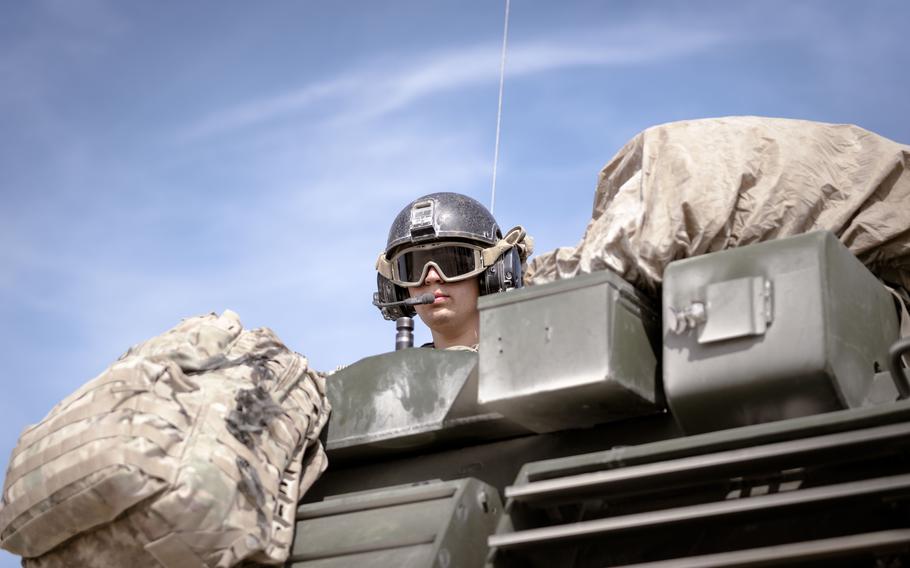
Army Staff Sgt. Shawn McDorr, a section chief with Alpha Battery, 1st Battalion, 77th Field Artillery Regiment, participates in his team's final exercise with the M270A1 Multiple Launch Rocket System at Grafenwoehr Training Area in Grafenwoehr, Germany, on Aug. 22, 2024. McDorr is looking forward to the impending switch to the A2 variant of the system. (Lydia Gordon/Stars and Stripes)
GRAFENWOEHR, Germany — Army Staff Sgt. Shawn McDorr was feeling little nostalgia this week as he waited to fire his mobile armored launcher for what was likely the last time.
The M270A1 Multiple Launch Rocket System, capable of traversing battlefields on tanklike treads, is set to be replaced with an updated A2 variant by the end of September, Capt. AJ Dorantes, a 41st Field Artillery Brigade spokesman, said Friday.
McDorr and his fellow artillerymen from Alpha Battery, 1st Battalion, 77th Field Artillery Regiment, took to the Grafenwoehr Training Area on Thursday for Falcon Strike 24, an annual platoon-level live-fire qualification.
The A1 can be kind of crowded at times, said McDorr, a crew chief from Bath, Maine.
“Part of the upgrade is that the new technology is built in better and hasn’t had to be added as an afterthought,” he said. “That’s a big plus in my book.”
The M270A1, which first entered service in a previous format in 1983, is an armored launcher mounted on a stretched Bradley chassis. The system is equipped with two containers that can fire either 12 rockets or two ATACMS guided missiles with a range of up to 190 miles.
They are crewed by three-man teams consisting of a driver, a gunner and a section chief that can deliver a payload in under 60 seconds, according to the Army website.
Artillery has always been integral to taking and holding territory, but its importance on the modern battlefield has been reemphasized by the war in Ukraine.
In March, Russia was firing about 10,000 shells per day, CNN quoted unidentified NATO officials as saying. Since then, Western allies have tried to replenish Ukraine’s smaller stocks while maintaining their own.
Based on what has been observed in Ukraine, the brigade’s two MLRS battalions in Bavaria are focused on increasing “survivability tactics,” particularly when it comes to drones, Dorantes said.
The 41st beefed them up earlier this year by adding a third battery to the 1-77 and its sister unit, 1st Battalion, 6th Field Artillery.
Each battalion had two batteries with eight launchers but are moving toward three with nine launchers, Dorantes said. Each battery will receive several A2s, he added.
The change is part of the Army’s strategy to move away from the close air support and counterfiring of the wars in Iraq and Afghanistan and back to large-scale combat operations, battalion commander Lt. Col. Anthony Dunkin said.
“We’re focused in the deep area,” he said. “Our mission is to be able to acquire the enemy deep and shape their formations before they can affect our troops on the ground.”
The consensus among members of the battery was that the A2s will usher in an improved work environment. In addition to revamped engines, armor, fire control systems and increased firepower, the upgraded and rebuilt transmissions will mean less maintenance and a faster return to the battlefield.
“That’s why it’ll make us overall more lethal,” gunner Sgt. Shane Stough said.
The Falcon Strike exercise, which began Aug. 8 and ended Friday, started with simulated “shoot-and-scoot” maneuvers in Baumholder. The training included long-distance convoy operations, an opposition force and small aerial drones.
On Tuesday, the battalion moved east to Grafenwoehr. While one system pulled onto the range and fired four rockets in succession, McDorr and Spc. Timothy Bess waited for their turn in a track dubbed “Second Coming.”
“We’re very aware of how much of a target we are and how much our weapon platform matters,” McDorr said.
They’re making sure that they move a lot and know how to use cover and concealment, he added.
“(Artillery) is usually the decisive factor in most wars that we’ve seen in the past,” McDorr said. “And I think we’re seeing a return to that.”